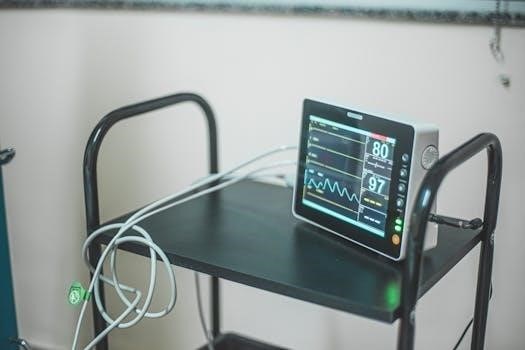
vital signs record sheet pdf
What is a Vital Signs Record Sheet?
A vital signs record sheet is a document used to track a patient’s basic health metrics. It records temperature, pulse, respiration, and blood pressure over time. This sheet aids healthcare providers in monitoring and detecting health changes.
Definition and Purpose
A vital signs record sheet is a structured form, either printed or digital, designed to systematically document a patient’s essential physiological measurements. These measurements typically include temperature, heart rate (pulse), respiratory rate, and blood pressure. The core purpose of this record is to provide a chronological overview of a patient’s health status, allowing healthcare professionals to observe trends, identify any deviations from the norm, and assess the effectiveness of treatments. It facilitates continuous monitoring, enabling early detection of potential health issues and ultimately contributing to improved patient care and outcomes. It is a fundamental tool in medical settings.

Key Vital Signs Tracked
A vital signs record sheet typically tracks four key metrics⁚ temperature, heart rate (pulse), respiratory rate, and blood pressure. These measurements provide crucial insights into a patient’s overall health.
Temperature
Body temperature is a vital sign often measured using a thermometer, reflecting the balance between heat production and loss. Recorded in degrees Celsius or Fahrenheit, it indicates the body’s metabolic activity and can signal the presence of infection or other health issues. Normal temperature varies, but deviations can be significant for assessment. Consistent tracking on a vital signs record sheet allows healthcare professionals to monitor fluctuations and respond appropriately. Accurate temperature readings are crucial for understanding the overall health status.
Heart Rate (Pulse)
Heart rate, or pulse, measures the number of times the heart beats per minute. It’s a vital indicator of cardiovascular function, easily assessed by palpating arteries, like the radial artery in the wrist. A normal heart rate varies, but a rapid or slow pulse can signal underlying health problems. Monitoring heart rate on a vital signs record sheet helps healthcare professionals track changes and identify potential issues. Regular recording aids in detecting trends and ensuring timely intervention when necessary.
Respiratory Rate
Respiratory rate is the number of breaths a person takes per minute. It’s a key indicator of pulmonary function, reflecting how well the body is absorbing oxygen and expelling carbon dioxide. A normal respiratory rate varies by age and health status; deviations can signal respiratory distress or other health issues. Recording respiratory rate on a vital signs sheet allows medical personnel to observe trends, monitor changes, and identify potential problems. Regular tracking assists in the early detection of respiratory abnormalities for timely treatment.
Blood Pressure
Blood pressure is the force of blood against artery walls, measured in millimeters of mercury (mmHg). It is typically recorded as two numbers⁚ systolic (when the heart contracts) and diastolic (when the heart relaxes). Monitoring blood pressure is vital for assessing cardiovascular health. Deviations from normal ranges can indicate hypertension or hypotension, which require medical attention. A vital signs record sheet provides a means of tracking blood pressure changes over time, assisting healthcare providers in managing a patient’s condition. Consistent monitoring helps in early detection of potential cardiovascular issues.

Importance of Using a Vital Signs Record Sheet
Using a vital signs record sheet is crucial for monitoring health trends and detecting early signs of health issues. This helps in timely intervention and better patient care.
Monitoring Health Trends
A vital signs record sheet facilitates the tracking of health trends over time. Consistent recording of measurements allows healthcare professionals to observe patterns and identify any deviations from normal ranges. This detailed approach helps in understanding the progression of a patient’s condition, whether it’s an improvement or deterioration. By monitoring these trends, adjustments to treatment plans can be made proactively, ensuring that patients receive the most appropriate care. Regular observation of vital signs provides an accurate overview of a patient’s health and enables more informed medical decisions.
Early Detection of Health Issues
Using a vital signs record sheet is crucial for the early detection of potential health problems. By regularly tracking key indicators like temperature, heart rate, respiratory rate, and blood pressure, subtle changes can be quickly identified. These changes might signal the onset of an infection, cardiovascular issues, or other underlying conditions. Early detection allows for prompt medical intervention, which can significantly improve patient outcomes and prevent more serious health complications. The consistent use of these sheets ensures no changes are overlooked and aids in timely treatment.
Types of Vital Signs Record Sheets
Vital signs record sheets come in two main formats⁚ printable PDF templates and digital templates. Both serve the same purpose, but offer different advantages in accessibility and usage.
Printable PDF Templates
Printable PDF templates are a common and accessible format for vital signs record sheets. They offer a simple, tangible way to document health metrics. These templates can be downloaded and printed for immediate use. They are often structured as tables, with columns for different vital signs and spaces for recording measurements over time. The ease of use and straightforward layout make them ideal for both healthcare professionals and individuals monitoring their health at home. These templates are also easily shared and can be stored physically for reference.
Digital Templates
Digital templates for vital signs record sheets offer a modern, efficient alternative to paper-based versions. These templates are often available as spreadsheets or within healthcare apps. They provide the convenience of electronic data entry and storage. Digital formats allow for easy sharing with healthcare providers and can facilitate data analysis. These templates often include features like automatic calculations and charting of trends. They can be easily accessed on various devices, promoting portability. Furthermore, digital templates can be customized and updated easily, providing flexibility for different needs. They also can store data and provide added security;

How to Use a Vital Signs Record Sheet
To use a vital signs record sheet, accurately measure and record each vital sign. Note the date and time of each reading. Ensure the sheet is stored properly for future reference.
Recording Measurements
When recording measurements on a vital signs record sheet, ensure accuracy and legibility. Note the specific reading for each vital sign, such as temperature, heart rate, respiratory rate, and blood pressure. Use the correct units of measurement. Be precise with the numbers. Include the date and time of each measurement. If using a paper sheet, write clearly and avoid smudges. When using a digital template, double-check that the data has been entered correctly. If there is a pain level, record that too. If there is a comment section, add any observations that are needed.
Frequency of Recording
The frequency of recording vital signs on the record sheet depends on the individual’s health status and the care setting. In hospitals, recordings might be done every few hours. In a home setting, once a day may be sufficient. If a person’s condition is unstable, more frequent monitoring is needed. Follow any specific guidelines from healthcare professionals. It’s crucial to record vital signs whenever there are changes in a person’s condition. Consistency is key to tracking patterns. If you miss a measurement, record it as soon as possible and note the time. If you have questions about the frequency of recording, consult with a healthcare provider.

Benefits of Using a Vital Signs Record Sheet
Using a vital signs record sheet allows for better monitoring of health trends; It aids in the early detection of potential health issues and provides valuable data for healthcare professionals.
For Healthcare Professionals
For healthcare professionals, a vital signs record sheet serves as a crucial tool for patient care. It provides a structured way to document essential physiological data, enabling accurate tracking of a patient’s condition over time. This detailed record facilitates informed decision-making regarding treatment plans and interventions. Moreover, it aids in identifying subtle changes that may indicate a developing health issue. The sheet ensures consistency in data collection, fostering better communication among healthcare teams. It also supports compliance with medical protocols and provides a valuable reference for future evaluations and research.
For Home Monitoring
For home monitoring, a vital signs record sheet empowers individuals to proactively manage their health. It allows for consistent tracking of key metrics, enabling early detection of potential issues. This record can be shared with healthcare providers, facilitating more informed consultations. The sheet promotes personal health awareness and encourages active participation in wellness management. By monitoring trends, individuals can make informed lifestyle adjustments and promptly seek medical advice when needed. The structured format simplifies the recording process, making it accessible to users without medical training. It helps in keeping an organized history of readings.
Additional Considerations
When using a vital signs record sheet, consider specific needs, such as pediatric or pregnancy monitoring. These situations may require different ranges and interpretations, so it is important to be aware of them.
Pediatric Vital Signs
Pediatric vital signs differ significantly from those of adults, requiring specific charts and ranges. Normal heart rates and respiratory rates are typically higher in children and infants. Therefore, it’s crucial to use a pediatric-specific vital signs record sheet. These charts often include age-related reference ranges to ensure accurate interpretation of measurements. Using adult ranges for children can lead to misdiagnosis. Always consult pediatric guidelines and use proper equipment when monitoring a child’s health. Regular and accurate monitoring is essential for early detection of health issues. Remember, what’s normal for an adult may be concerning for a child.
Pregnancy Monitoring
During pregnancy, vital signs monitoring is crucial for both the mother’s and the baby’s health. Blood pressure fluctuations are common, so regular checks are essential to detect preeclampsia or hypertension. Increased heart rate is normal during pregnancy due to increased blood volume. Monitoring temperature can help identify infections. A vital signs record sheet allows for easy tracking of these changes. Any significant deviations from the normal ranges should be reported to a healthcare provider immediately. Consistent monitoring supports early intervention and ensures a healthier pregnancy journey. Remember to follow your healthcare provider’s specific guidelines and recommendations for vital signs monitoring.

